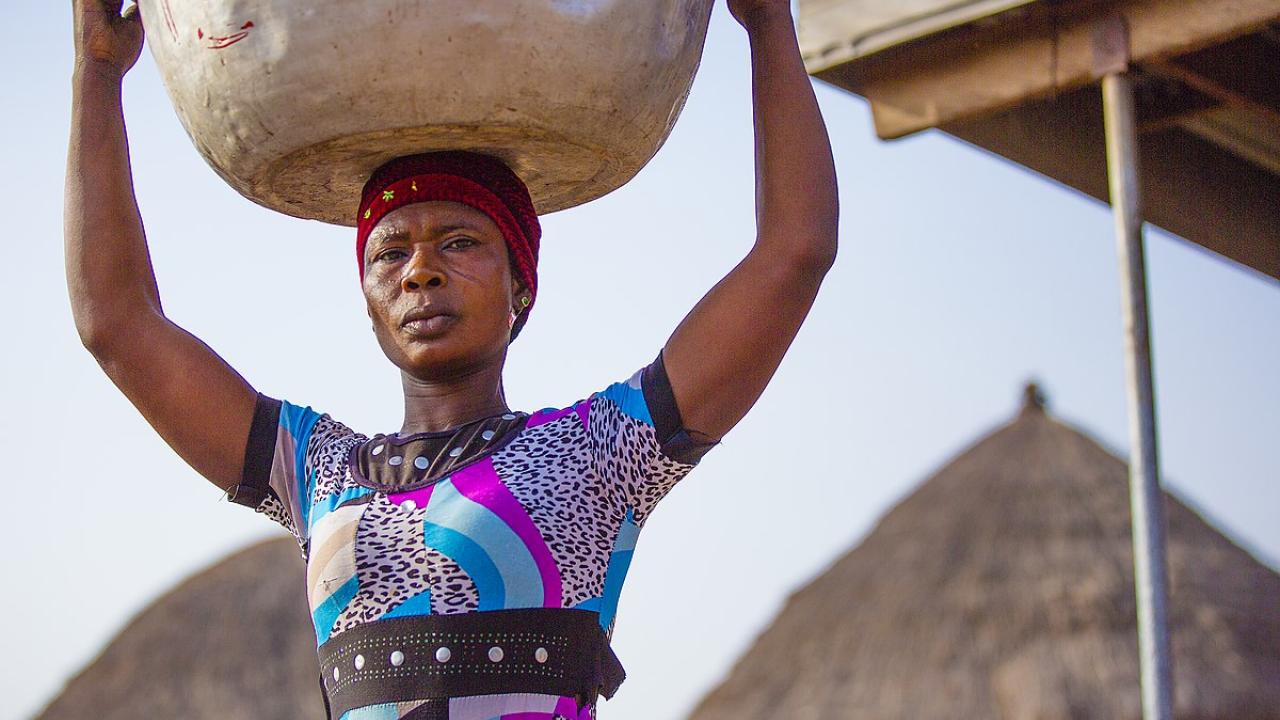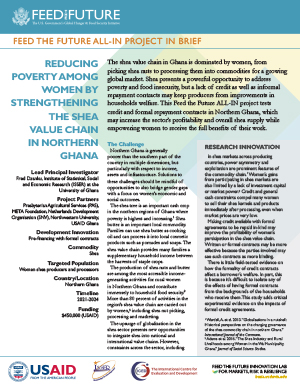
The shea value chain in Ghana is dominated by women, from picking shea nuts to processing them into commodities for a growing global market. Shea presents a powerful opportunity to address poverty and food insecurity, but a lack of credit as well as informal repayment contracts may keep producers from improvements in households welfare. This Feed the Future ALL-IN project tests credit and formal repayment contracts in Northern Ghana, which may increase the sector’s profitability and overall shea supply while empowering women to receive the full benefits of their work.
Project Overview
Lead Principal Investigator: Fred Dzanku, Institute of Statistical, Social and Economic Research (ISSER) at the University of Ghana
Project Partners: Presbyterian Agricultural Services (PAS), META Foundation, Netherlands Development Organisation (SNV), Northwestern University, USAID Ghana
Development Innovation: Pre-financing arrangements with formal repayment contracts
Commodity: Shea
Targeted Population: Women shea producers and processors
Country/Location: Northern Ghana
Timeline: 2021-2024
Funding: $526,983 (USAID)
The Challenge
Northern Ghana is generally poorer than the southern part of the country in multiple dimensions, but particularly with respect to income, assets and infrastructure. Solutions to these challenges should be mindful of opportunities to also bridge gender gaps with a focus on women’s economic and social outcomes.
The shea tree is an important cash crop in the northern regions of Ghana where poverty is highest and increasing.[1] Shea butter is an important local commodity. Families can use shea butter as cooking oil and can process it into local cosmetic products such as pomades and soaps. The shea value chain provides many families a supplementary household income between the harvests of staple crops.
The production of shea nuts and butter are among the most accessible income-generating activities for rural women in Northern Ghana and contribute immensely to household food security.[2] More than 80 percent of activities in the region’s shea value chain are carried out by women,[3] including shea nut picking, processing and marketing.
The upsurge of globalization in the shea sector presents new opportunities to integrate shea into national and international value chains. However, constraints across the sector, including shea producers’ lack of negotiating power, severely limit how much the value chain can reduce women’s poverty and food insecurity.
Credit to be repaid with shea nuts at a pre-negotiated rate may overcome some of these challenges, particularly if credit contracts are formal or written rather than only verbal. Written or formal contracts may be more effective because the parties involved may see such contracts as more binding. There is also no experimental evidence on how the formality of credit contracts affects a borrower’s welfare.
Research Design

This Feed the Future ALL-IN study led from the Institute of Statistical, Social and Economic Research (ISSER) at the University of Ghana is testing whether credit and formal credit contracts affect the total supply of shea nuts in the sector and the household welfare of women shea producers in Northern Ghana. This randomized controlled trial (RCT) includes 2,715 rural households selected in collaboration with Presbyterian Agricultural Services (PAS), META Foundation and the USAID Ghana office.
This RCT makes it possible to rigorously test the impacts of credit contract formality on household welfare by randomly assigning similar households to receive either a verbal credit contract or a written one. The study includes a total of 2,715 women shea producers from 135 communities who are randomly assigned to one of three groups:
- Credit with verbal contract: 800 participants receive credit with only a verbal contract to repay with shea kernels.
- Credit with written contract: 800 participants receive credit with written contracts to repay with shea kernels.
- Control: 1,115 women will receive no programming and their outcomes will provide a comparison to estimate the average impacts for participants in the two experimental groups.
Providing both credit and formal contracts may increase the shea kernel supply and profits in part because together they guarantee a minimum stable price. The formal written contract may also improve supply by reducing side selling or price changes that undermine contact arrangements.
Development Impact
Over the past decade, the shea value chain has consistently featured in initiatives from the Government of Ghana, USAID and other development partners seeking to bridge the north-south divide in poverty and food security. This project could increase the profitability of shea processing by improving the coordination of supply and demand, which in turn could increase investments in the sector.
Women in particular will benefit from strengthening the shea sector. Strengthening a sector that can increase women’s access to cash income and overall social and economic empowerment could also bridge gender gaps in social and economic outcomes.
This project seeks to address key challenges that keep women and their communities from higher profits and incomes as well as an increased overall supply within the shea value chain. Better prices for productivity, a greater total quantity of marketable shea products and better market coordination should all increase shea value chain profits, while also increasing women’s social and economic empowerment.
[1] Ghana Statistical Service, 2018
[2] Hatskevich et al. 2014. “Shea butter processing as an engine of poverty reduction in Northern Ghana: Case study of four communities in the Bolgatanga Municipality.” African Journal of Agricultural Research.
[3] Yayah, A. 2020. “Investigating the sustainability of the shea industry among rural women in Northern Ghana.” Stellenbosch University.
This report is made possible by the generous support of the American people through the United States Agency for International Development (USAID) cooperative agreement 7200AA19LE00004. The contents are the responsibility of the Feed the Future Innovation Lab for Markets, Risk and Resilience and do not necessarily reflect the views of USAID or the United States Government.
